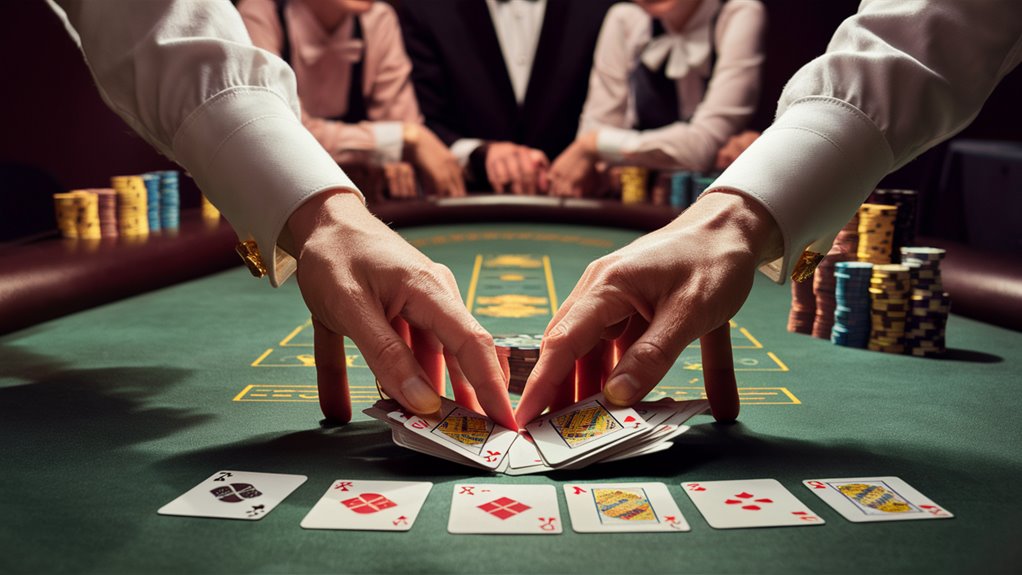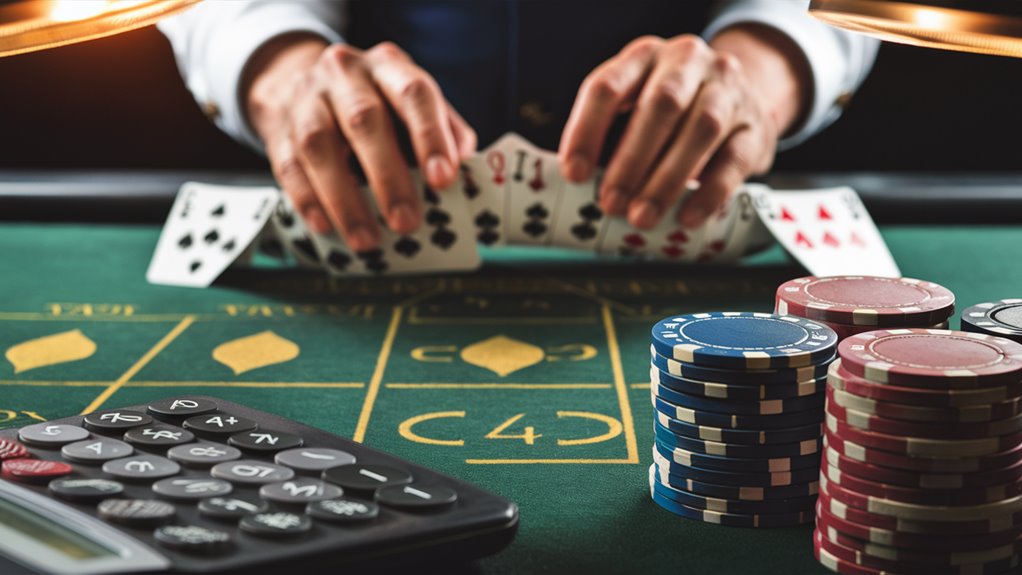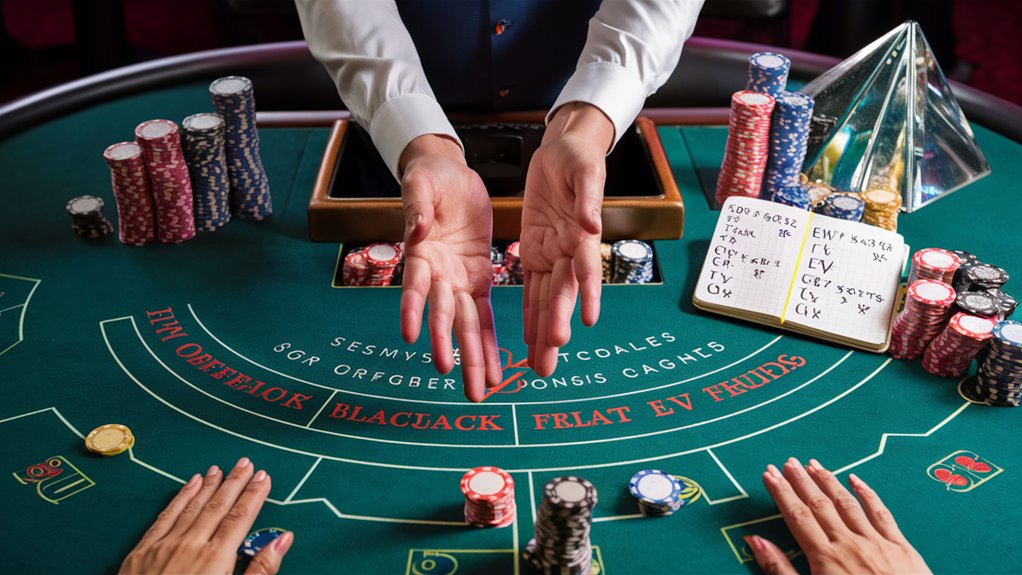
Winning Live Dealer Games with Math Strategy

Knowing Casino Math and House Edge
The key to good live dealer play is math probability and knowing the house edge percentages. In baccarat, the banker bet has a small 1.06% house edge, while American roulette has a 5.26% house edge. These main numbers help you make smart choices.
Deep Stats Methods
Handling Variance
Stats variance math helps players foresee and get ready for normal changes in outcomes. Using the Kelly Criterion for best bet sizing helps grow your money most while keeping risk low. Sticking to a 1-3% bankroll rule per bet guards you from variance.
Bet-Specific Math
Blackjack decision grids cover over 250 different plays, each needing exact math thinking. Baccarat probability charts show clear stats trends that guide your bets. Roulette geometric math points out the best bets and coverages.
Using Probability-Based Strategy
Good live dealer play needs:
- Stats modeling for predicting outcomes
- Using probability theory
- Managing risks
- Calculating mathematical edge
- Optimizing your money use
Knowing these math rules builds a plan for smart choices in all live dealer games, pushing up possible gains while cutting risk from variance.
Basic Chances in Live Games
Knowing Simple Chance in Live Casino Games
Main Math Ideas in Live Dealer Games
Learning the key chances in live dealer casino games is key for smart play.
In live dealer blackjack, the normal 8-deck game has a 4.75% house edge, meaning a likely loss of $4.75 for every $100 bet in the long run.
House Edge Review for Well-Liked Live Games
Live Baccarat Chances
Banker bets in live baccarat keep a 1.06% house edge, while player bets have a 1.24% disadvantage.
These numbers include the normal 5% fee on winning banker bets.
Live Roulette Types
European roulette wheels with one zero spot have a 2.7% house edge.
In contrast, American roulette wheels with both 0 and 00 spots have a 5.26% house edge.
Side Bet Chance Review
Side bet chances usually have much higher house edges, often more than 10%.
Clear examples include perfect pairs in blackjack, where the house edge goes from 4% to 11%, changing with specific game rules and pay setups.
Knowing these core game chances helps players make smart choices in all live dealer games.
Knowing House Edge Math
Knowing Casino House Edge Math
The Math Behind Casino Gain
The house edge math shows the key math edge that makes sure casinos make money from all games. This key number tells the chance of results and their linked pays.
Doing House Edge Math
To find the casino house edge, multiply the chance of each possible result by its pay, then take 100%.
European Roulette shows this well with a -2.7% edge, found from all 37 possible results and their pays.
Blackjack house edge math includes many parts:
- Dealer’s first card spot
- Player choice points
- House rule changes
- Deck use
House Edge Changes by Game Kind
Old Casino Games
- European Roulette: -2.7%
- Blackjack: 0.5% to 2%
- Baccarat: 1.06% (banker bet)
- Craps: 1.36% (pass line)
Live Dealer Platforms
Live casino games keep the same math edges as their real-life versions, using the same basic rules and pay setups.
More points to think about include:
- Time limits for choices
- Network link factors
- Platform-specific rules
Long Game Stats Impact
The house edge percentage shows up clearly over a lot of play, no matter the small-time changes.
This math truth drives casino wins through:
- Big set size chance
- Stats regression
- Based on lots of games returns
Knowing these math ideas helps you make smart game choices based on math chance not just luck.
Variance and Money Plans
Knowing Variance and Money Plans in Betting

The Role of Variance in Betting Results
Variance and money plans are main parts that set real-world betting results, beyond simple house edge math.
Stats variance, which checks result spread around expected values, makes big short-term performance changes.
Even with low house edges of 1%, play times often see big move swings of ±20% because of normal spread patterns.
Must-Know Money Rules
Risk of Ruin Math
The Risk of Ruin (RoR) math gives key money size tips:
RoR = ((Q-P)/(Q+P))^N
- Q = losing chance
- P = winning chance
- N = number of money bet units
Pro betting rules say to keep at least 100 bet units for live dealer games to keep RoR under 1%.
Kelly Math Best Sizing
The Kelly math finds the best bet size:
Best bet = (BP-Q)/B
- B = bet pay
- P = winning chance
- Q = losing chance
This math bet plan usually hints at betting 1-3% of total money per hand in live dealer casino games for best growth and last.
Best Bet Plans
Best Bet Plans: A Math Way
Main Math Points for Bet Wins
Best bet plan making leans on three key math points: looking for most expected value, handling swings, and making money grow.
Math models show keeping bet sizes between 1-3% of total money is best for balance of growth chance and risk plans.
Deep Bet Math and Ways
The Kelly math is a main way for pro bettors, finding best bet size as edge divided by pay.
For better risk plans, using a part Kelly way – usually 1/2 or 1/4 of the full Kelly bet – cuts swings while keeping growth chance.
Risk Plans and Bet Sizes
Step-up bet systems like Martingale always lead to no money despite looking good at first.
A set percent betting plan is much better math-wise, with changes only for big edge or money changes.
Best Bet Math
For best results, use this sharper bet math:
Bet Size = (Money × Edge × Risk Factor) / Variance
The Risk Factor should be between 0.5-0.75 for safe bet ways.
This math plan makes most of long-term expected value while keeping you safe from big downs.
Main Points for Wins
- Money Plans: Stick to percent-based betting
- Risk Checks: Keep looking at edge and swings
- Bet Sizes: Change based on math points
- Performance Checks: Look at bet results often
This plan helps keep growth while cutting risk in bet moves. 추천 업체 리스트 확인
Game-Specific Math Ways
Game-Specific Math Plans for Live Dealer Games
Math Basics for Blackjack
Blackjack plans need knowing conditional chance math, with wins based on a full decision grid covering about 250 plays. Visibility Plays Into High-Energy End Rounds
The basic plan frame checks win chances based on the mix of player cards and the dealer’s seen card.
Baccarat Chance Study
Baccarat math is all about plain chance math without conditional bits.
The house edge gap between banker bets (1.06%) and player bets (1.24%) is key for smart betting, while fee setups change overall expected returns.
Roulette Stats Models
Geometric spread math runs roulette study, mainly for streak chance math.
Main changes are there between European roulette (2.7% house edge) and American roulette (5.26% house edge), though each spin keeps stats on its own.
Live Poker Math Frame
Live dealer poker types need live math study using pot odds and implied odds math.
Smart choices need non-stop chance changes based on betting moves and spot-specific bits.
Top players mix live odds math with how other players tend to play for best results.
Risk Vs Expected Value Study
Risk vs Expected Value Study in Live Dealer Games
Knowing Expected Value Math
The main part of winning live dealer plans is mastering how risk checks and expected value math work together.
Smart betting choices must be checked through full math models while taking in both swings and possible losses.
Doing Expected Value and Risk Math
Expected value (EV) math needs multiplying each possible result by its chance and adding them all up.
But, full checks need looking at risk parts through checking normal spread and biggest downside risk.
In live blackjack plays, a $100 double down chance may show a positive EV of $15, while having a big risk of losing the full $200 stake.
Best Risk-to-EV Ratios
Keeping a risk-to-EV ratio under 4:1 is best for single choice plans. This math frame means keeping risk low to $400 when going after an expected value of $100.
This tested way helps keep your money safe while making most of long-game wins.
Putting a number on both reward chance and downside risk helps make data-led choices during high-stakes live play times.
Main Risk Plans:
- Work out expected value for each betting chance
- Look at normal spread and swings metrics
- Stick to strict risk-to-EV ratio rules
- Focus on math not feelings in choices
- Watch money risks in a set way


